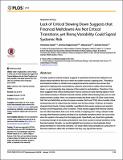Lack of critical slowing down suggests that financial meltdowns are not critical transitions, yet rising variability could signal systemic risk

View/
Date
2016-01-13Author
Raghavendra, Srinivas
Metadata
Show full item recordUsage
This item's downloads: 226 (view details)
Recommended Citation
Guttal V, Raghavendra S, Goel N, Hoarau Q (2016) Lack of Critical Slowing Down Suggests that Financial Meltdowns Are Not Critical Transitions, yet Rising Variability Could Signal Systemic Risk. PLoS ONE 11(1): e0144198.
Published Version
Abstract
Complex systems inspired analysis suggests a hypothesis that financial meltdowns are abrupt critical transitions that occur when the system reaches a tipping point. Theoretical and empirical studies on climatic and ecological dynamical systems have shown that approach to tipping points is preceded by a generic phenomenon called critical slowing down, i.e. an increasingly slow response of the system to perturbations. Therefore, it has been suggested that critical slowing down may be used as an early warning signal of imminent critical transitions. Whether financial markets exhibit critical slowing down prior to meltdowns remains unclear. Here, our analysis reveals that three major US (Dow Jones Index, S&P 500 and NASDAQ) and two European markets (DAX and FTSE) did not exhibit critical slowing down prior to major financial crashes over the last century. However, all markets showed strong trends of rising variability, quantified by time series variance and spectral function at low frequencies, prior to crashes. These results suggest that financial crashes are not critical transitions that occur in the vicinity of a tipping point. Using a simple model, we argue that financial crashes are likely to be stochastic transitions which can occur even when the system is far away from the tipping point. Specifically, we show that a gradually increasing strength of stochastic perturbations may have caused to abrupt transitions in the financial markets. Broadly, our results highlight the importance of stochastically driven abrupt transitions in real world scenarios. Our study offers rising variability as a precursor of financial meltdowns albeit with a limitation that they may signal false alarms.
Description
Journal article

